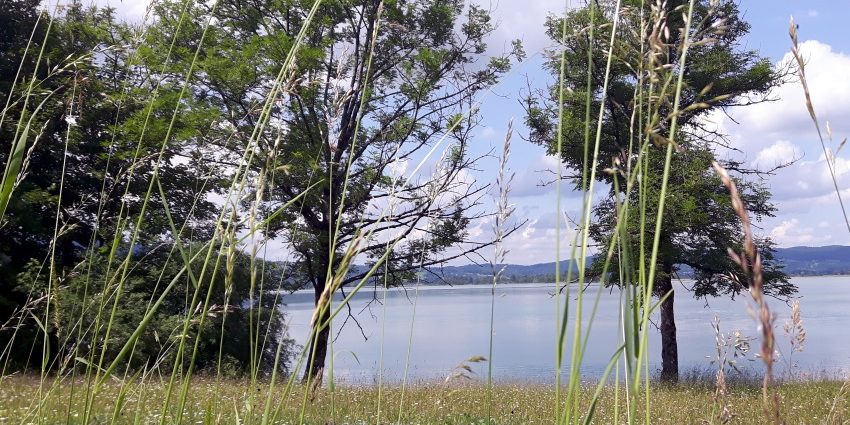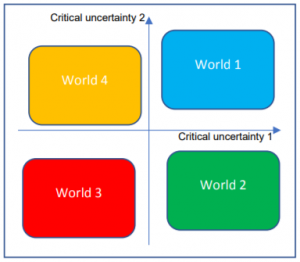Scenario analyses are of high relevance in the context of strategic management in order to prepare a company for various future stages. Their functional applications are extremely diverse. The following blog post provides an overview of what scenario analyses are and in which contexts this tool can be used, especially in relation to sustainability and environmental management.
The scenario analysis for strategic foresight activities
Regarding corporate management, the use of scenario analyses became increasingly important in the early 1970s due to the oil crisis. In this context, the oil company Shell is the best-known pioneer, whose strategy was supplemented by variably developed scenarios (Krystek & Herzhoff, 2006). The core of a scenario analysis is to replicate various future stages and to identify causalities between changing environmental conditions and (future) processes (see Gabler Wirtschaftslexikon, 2018). This allows a company to prepare for various developments in the best possible way (Krystek & Herzhoff, 2006). Due to constantly changing situations, the intention of such analyses is to integrate flexibility and dynamism into (future) entrepreneurial behaviours and functions.
The focus is on the identification of essential variables and factors in order to create possible futures based on these elements. The visual representation of the analysis differs depending on the context (see e. g. Fig. 1 and Fig. 2). Classically, the scenario analysis is presented in the form of a funnel, whereby three possible stages of development are represented in form of a ‘best case’, ‘trend case’ and ‘worst case’ (see Fig. 1). Based on these scenarios, appropriate action paths are designed. Afterwards companies will focus on one path primarily.
Fig. 1: Representation of the scenario analysis as a funnel (Mietzner, 2009, p. 119)
Fig. 2: Scenario matrix based on defined uncertainties (CDP Technical Note on Scenario Analysis, 2018, p. 5)
The central element in such analyses is to define a long planning horizon (at least five to ten years). As a consequence of a multi-stage process, the different scenarios are created, whereby the methodical procedure can be conducted by qualitative or quantitative models (see Gabler Wirtschaftslexikon, 2018):
- Analysis of the framework conditions and the current state: Presentation of the problem, collection of potential variables, consistency checks
- Forecasting stage: Identification of possible developments, determination of possible consequences
- Synthesis stage: Creation of scenarios with results of the second phase
- Implementation stage: Results are integrated into the context-relevant functional planning process
Advantages and disadvantages of scenario analyses
The application of scenario analyses offers numerous advantages. However, there are also some inevitable disadvantages inherent in the use of this tool. Below, three advantages and disadvantages are listed (advantages and disadvantages according to Mietzner, 2009, p. 160 f.):
Advantages:
- Improvement of the competence for assessments
- Valid analysis of uncertainties which generates competitive advantages
- Development of preventive and reactive measures in the context of strategic planning
Disadvantages:
- Dependence on subjective assessments of the actors involved in the process
- The quality of results depends on the professional qualifications of the persons involved and depends on the techniques and methods used
- Time and resource intensive
Application examples for scenario analyses in the context of sustainability
Scenario analyses play a significant role in a variety of contexts. In addition to its use in the strategic planning process, it is used within corporate sustainability controlling in order to prepare specifically for future changing factors. It is also a suitable tool for risk management to identify potentially relevant sustainability risks and opportunities and to forecast their impact on various corporate futures.
Scenario analyses are also in the context of this year’s CDP season important. Based on the TCFD (Task Force for Climate-related Disclosures) recommendations, CDP asks participating companies if and how they use scenario analyses in the context of climate and water-related factors in order to inform their business strategy regarding climatic and water-related changes. For such scenario analyses, CDP has developed a separate guide companies can use (available here). In this context, also the Science Based Targets (SBTs) are important because in terms of climate aspects they can be used analogy to the scenario analysis. These are designed on a similar basis, i. e. they are also based on scenarios (information on the SBTs can be found on our homepage and in our blog). Companies that already use SBTs can use their ‘content’ for the relevant CDP answers.
Appraisement of scenario analyses and support by the DFGE
In DFGE’s opinion the use of scenario analyses is extremely useful. Regardless of the high requirements, this tool helps to map the major risks, trend factors and challenges of the future. This allows companies to prepare for various developments in a flexible and dynamic way and thus, derive appropriate action strategies. This helps to mitigate risks and supports other stakeholders (e. g. investors, clients) in their decision-making as well.
If your organization needs help in building scenario analyses or SBTs, DFGE can support you. In addition, the DFGE supports companies in their reporting requirements for CDP Climate Change and CDP Water with individual services. In case of any questions or requests, don’t hesitate to contact us by e-mail at or by phone at 08192-99733-20.











